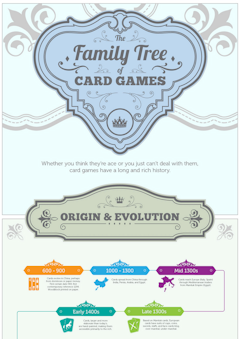To give you a broad overview
 of the history of western cards games and their origins in the east you can see a nice infographic - the first of its kind,
I believe - at the site of its originators
3cardpoker.com.
of the history of western cards games and their origins in the east you can see a nice infographic - the first of its kind,
I believe - at the site of its originators
3cardpoker.com.
The list is not complete - it never could be - but most of the great historical and modern games of the western world are there. What makes any game "great" is the fact that it it's played by a large community, often an entire country, for a notable period of time, typically at least a century. A historic game remains great, even when no longer played, if it has given rise to equally substantial descendants. For example, Bridge (20th century) goes back through Whist (18th - 19th centuries) to trick-taking games played as early as the 1400s. Poker, likewise, goes back through Poque (18th century) to the German game of Poch, also with roots in the 1400s. Obviously, with games developed in the last few decades it's impossible to tell whether any particular one will last long enough into the future to deserve the epithet "great". This applies more especially nowadays since the expansion of the internet has caused nationa games and variations to transcend their geographical boundaries.
A word of caution: Don't take the connected lines of descent as literal. For example, the type of game nowadays represented by Hearts was preceded by historically similar games such as Reversis and Losing Lodam, but this doesn't mean that any of the earlier examples itself evolved directly into a later one. It just means they're the same sort of game that requires the same sort of thinking to play well. More so than in the animal kingdom, the evolution of card games is riddled with hybrids. For example, Bridge combined elements of partnership Whist and (ultimately) Boston Whist, while Calypso can be classified as either a Bridge-like trick-taking game or a Rummy-type matching game, depending on which aspect you consider more significant.
It's also important not to attach too much precision to dates. For example, Gin Rummy achieved its greatness as a fad game of the 1940s, but first appeared under another name in the first decade of the 20th century and, structurally, differs very little from its 19th-century progenitor Conquián. In earlier times game descriptions would not reach the proto-Hoyle game books until the game concerned had already a long but unrecorded history behind it. And books of rules themselves did not appear until the 17th century, so for games earlier than that we depend on written references in literature from a wide variety of fields, from novels to city ordinances.
And then, beyond that, we have the problem of nomenclature, for some games are known by different names, some names apply to different games, and some games we know only by name and can't be certain exactly what they refer to. Examples of ambiguity include Michigan, which applies both to a form of Rummy and the Stops game known in Britain as Newmarket, and Manille, which applies to both a Stops game and a totally unrelated trick game.


